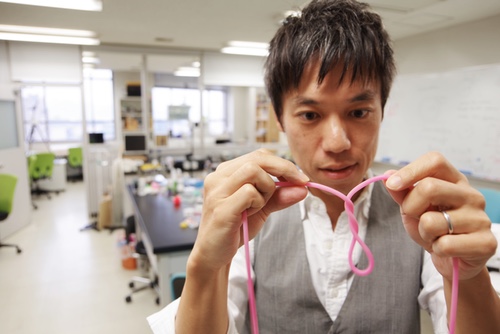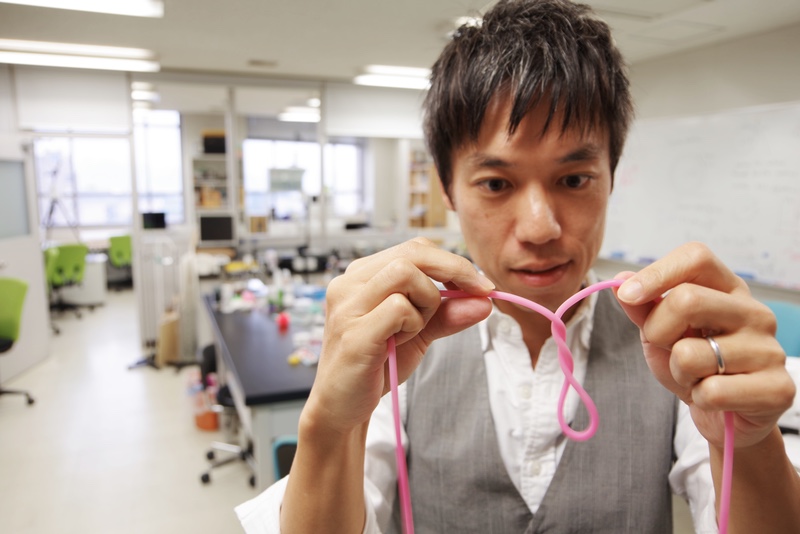Q&A: The Physics of the Everyday
Hirofumi Wada’s office could double as a toddler’s playpen. He keeps a floppy blue wand and an origami accordion by his desk. A fabric rainbow-colored ribbon, loosely coiled into a helix, hangs from his ceiling. But these toys aren’t playthings: Wada, who works at Ritsumeikan University near Kyoto, Japan, analyzes the intricate motions these objects undergo when they are stretched, bent, or dropped. Along with students and postdocs, he develops experiments, simulations, and analytical theories to understand their behavior. For example, Wada’s group elucidated the conditions that make a looped ribbon crease or pop inside out (see video). For him, no question is mundane—he finds interesting problems to solve in how plastic bags tear and why drinking straws bend. In a conversation with Physics, Wada explains his fascination with understanding the physics of children’s toys and other everyday objects.
–Sophia Chen
You classify your interests as “kitchen physics.” What is kitchen physics?
Kitchen physics tries to explain phenomena you observe in daily life, like why curled paper droops differently under gravity than a flat sheet or how water clings to the top of a liverwort plant. Some physicists may think these phenomena are trivial. But when you try to explain their behavior, you realize you don’t actually understand what’s going on.
For example, my group is studying the mechanics of a paper spring—an origami-esque structure made by gluing and folding together two thin strips of paper. Paper isn’t stretchy, but the paper spring behaves elastically (see video). And it isn’t obvious why that behavior occurs.
What led you to this field of study?
Ten years ago, my interest was in understanding the mechanical behavior of biological structures such as flagella, which are whip-like structures that microorganisms use to propel themselves. Gradually, my focus widened to the mechanics of rods, ribbons, filaments, sheets, and shells. Because of their geometry, describing the motion of these objects is nontrivial. Take a simple rod for example. If you push down on both ends of the rod, small sections of it will start to rotate with respect to their neighbors. These small rotations build on each other in a way that isn’t obvious, and eventually the rotations cause the whole rod to buckle.
Also, Ritsumeikan University is education oriented rather than research oriented, and kitchen physics is great for engaging students. It can be difficult for students to picture an electron or imagine what the Universe looked like just after the big bang. But they can see, touch, and play with the toys in my lab.
Why did you choose to work at a teaching university?
Research universities can pressure you to publish. But at my teaching university, I have the opportunity to talk to students and pursue physics projects just for fun—we do publish but we aren’t obligated to do so. I encourage the students to take on whatever project interests them. And I do like teaching a lot.
Where do you find all the different toys you study?
My students, my postdocs, and I are always on the lookout for objects worth studying. For example, I’ve brought in spinning tops, a thick syrup called mizuame used to sweeten Japanese candy, and even a french fry box from McDonald’s. The students also show me phenomena that they find funny or strange, like when you drop a regular sheet of paper in a confined container, air resistance causes it to float in an unexpected way. Most of the objects are cheap, and the lab is cluttered with toys and junk!
My kids also give me ideas. I have two boys who are 5 and 3 years old. They like to play with a toy called a jumping popper, which is a shell-shaped rubber toy that you push on to invert it. When it returns to its original shape, it launches into the air. While we haven’t worked on the popper itself, we studied similar behavior in curved vinyl strips that pop inside out when you clamp down one end and push on the other end with enough force. We derived a scaling law, based on geometrical arguments, that predicted the critical strain required for the strip to pop.
Does what you’ve learned about the physics of jumping poppers and other toys have links to other systems?
Yes, my group collaborates with biologists to study the mechanics of plants and bacteria because the toys we study have many analogs in nature. Researchers in the US found that the Venus flytrap captures prey using a similar mechanism to the jumping popper—the part of the plant that snaps closed has a mechanical instability analogous to that of the popper. And our experiments with a soft rod twisting around a cylinder mimic the mechanisms by which climbing plants move up using their tendrils.
Sophia Chen is a freelance writer based in Tucson, Arizona.
Know a physicist with a knack for explaining their research to others? Write to physics@aps.org. All interviews are edited for brevity and clarity.





